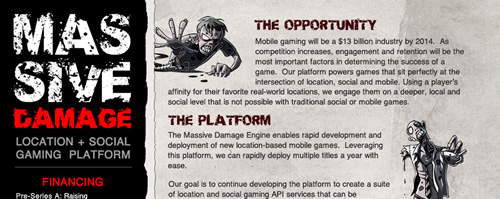“Do you have some time for a coffee or beer to chat about my startup?” – Anonymous entrepreneur
I’m happy to talk to entrepreneurs, learn about your startup and even help you out if I can. Since I have a bad habit of over committing and taking on too many activities. Let’s see there’s DemoCamp, Founders and Funders, StartupEmpire, my job (yes, I work at Microsoft), and a personal life (think 2 kids under the age of 2). Things are chaotic and busy, I’m starting to ask entrepreneurs to help me. So without more information, the answer to the above question is “maybe, help me understand why we should me”.
This sounds familiar. It’s similar to the problem faced by investors (made more pronounced with time-constrained applications), and journalists, and customers.
“If we get 1000 applications and have 10 days to read them, we have to read about 100 a day. That means a YC partner who reads your application will on average have already read 50 that day and have 50 more to go.” – YCombinator How To Apply
We talk about an Elevator Pitch. Except this isn’t a world where you might have forced my focus of attention by being artificially trapped in an elevator. The goal is like a newspaper headline. It’s to make me read the rest of the story. You need to stand out. You have to be able to simply, clearly convey what your startup is going to do. The YCombinator team do a great job describing what they look for in How To Apply. The initial filtering criteria for a YC application are obviously different than the criteria that journalists use to find stories, and different that what I use when determining to take a meeting or how I can help a startup. But the process is the same.
“What is your company going to make?" This isn’t the question I care most about, but I look at it first because I need something to hang the application on in my mind.
The best answers are the most matter of fact. It’s a mistake to use marketing-speak to make your idea sound more exciting. We’re immune to marketing-speak; to us it’s just noise.” – YCombinator How To Apply
This is about stand out from the pack. And helping the reader/journalist/audience member figure out who you matter to and why. Think of this as demand generation. You’re driving awareness and interest in your company, your team, your solution. The number one key is to be empathetic to the person whose attention and imagination you are trying to capture. Put yourself in the shoes of your intended audience, and help them understand what is special about your company, your product, you.
“Boil down your elevator pitch to one sentence. Tell us what you sell or do in very concrete language. This sets the context for the rest of your presentation.” – David Rose
Here’s an attempt to write that opening description for a few local startups.
- FreshBooks is a QuickBooks killer. It is a web-based accounting system allows small businesses to have accurate, professional estimates, time tracking, and invoicing.
- Well.ca is Canada’s online drugstore. Strong sales growth over past 3 years, raised $1.1M from angel investors in July 2009, technology focused with strong customer service.
- Rypple is a web application that gathers anonymous feedback from anyone. Peter Thiel is an investor. Founders have a strong track record at Workbrain.
- Dayforce is an rich internet application and web service that allows managers to visualize and plan their employees schedules and the employees to enter their timesheets. Founders have strong track record including Workbrain.
- Kiiro is a social project management application built on SharePoint. It uses the web and Microsoft Project to improve collaboration between the project managers and the team on larger projects.
- CoverItLive is web application for live blogging events. Companies, conferences, individuals can connect photos, tweets, live video, and rich media during events.
This is just the beginning. But that is the point. The goal is to entice the reader to want to know more. Ideally I’d love to see a short description of what you’re building. A clear identification about how you think you’re going to make money. What you think your secret sauce is. And a brief summary of key team members. Sound familiar. It’s very similar to the advice that David Rose provides as a Pitch Coach. The goal is to take basic pitch information and digest it into a smaller, customized components for your audience. It means that entrepreneurs are going to have stop being ego-centric and start thinking about others. You need to understand what is important to the individual that you are trying to reach and to shape your message appropriately.
For me, I want to understand what your company does/builds; the management team; the market opportunity; the business model; the stage of corporate development (pre-funded, funded, pre-revenue, etc.); why you think I care about this; and what your ask is of me. Is that too much to ask?
Open challenge to local startups to “pitch” for a meeting in a 140 characters or less in the comments (more realistically less than 420 characters – basically 3 tweets).
Resources

